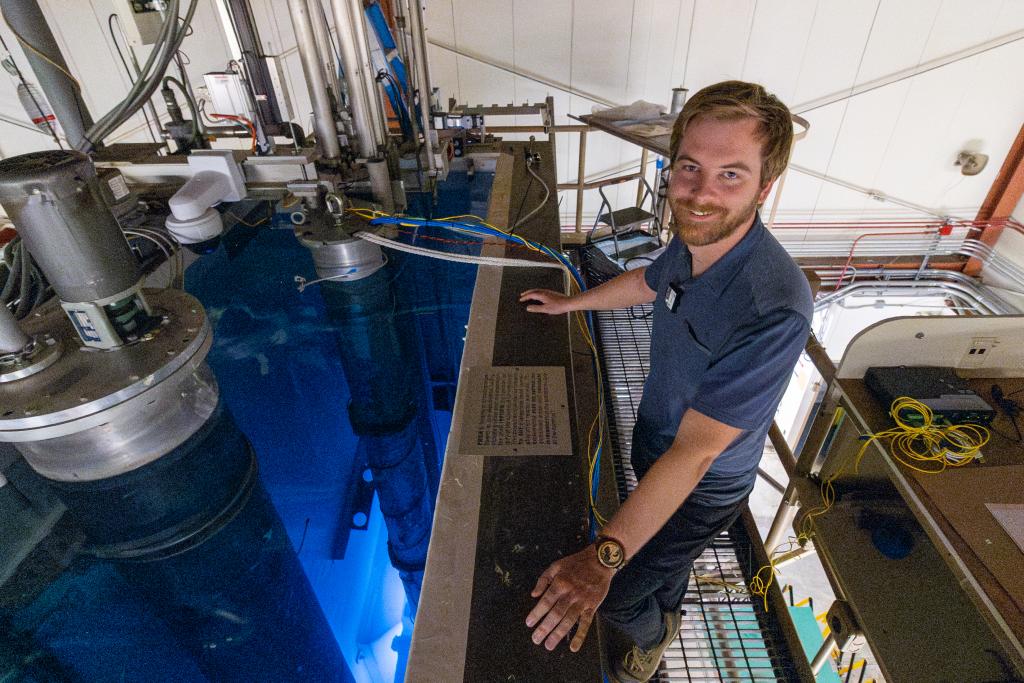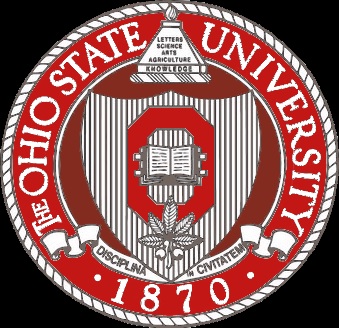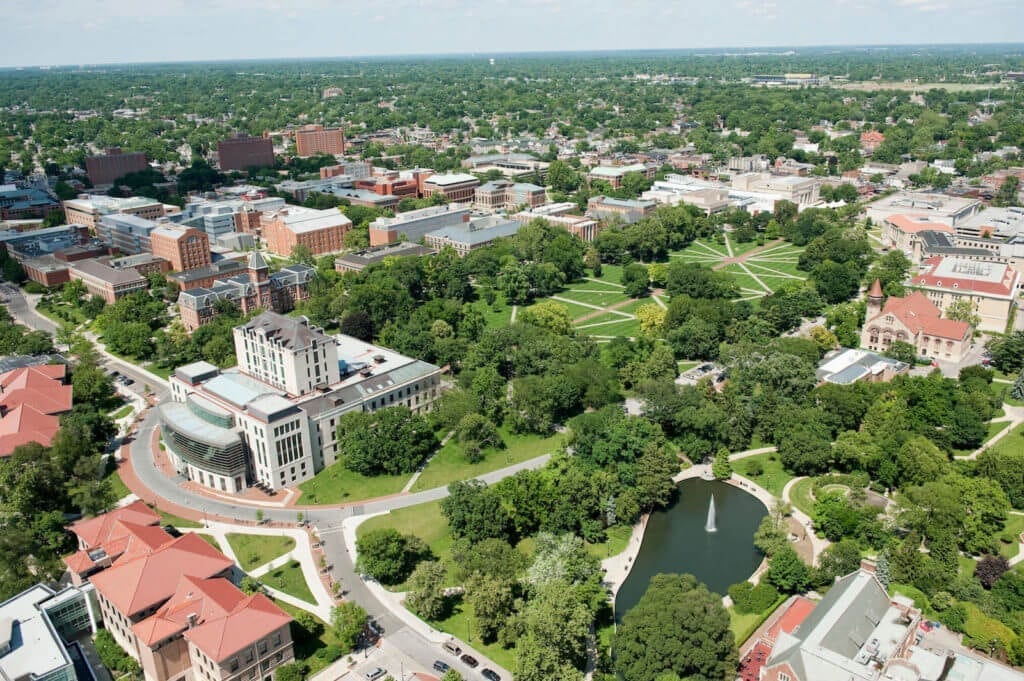From The DOE’s Oak Ridge National Laboratory
And
6.24.24
MEDIA CONTACT
S Heather Duncan
duncansh@ornl.gov,
478.718.9246
Science Contacts:
F. Kyle Reed
reedfk@ornl.gov
865.574.6643
N Dianne B Ezell
Group Leader
bullnd@ornl.gov
865.574.4368
Nance N Ericson
ericsonmn@ornl.gov
865.574.5637
Brett B Witherspoon
witherspoocb@ornl.gov
865.341.2053

ORNL’s Kyle Reed led a team testing an ORNL-made, hardy new type of transistor in the reactor pool as it glows with radiation at The Ohio State University Nuclear Reactor laboratory. Credit: Michael Huson/The Ohio State University
The safety and efficiency of a large, complex nuclear reactor can be enhanced by hardware as simple as a tiny sensor that monitors a cooling system. That’s why researchers at the Department of Energy’s Oak Ridge National Laboratory are working to make those basic sensors more accurate by pairing them with electronics that can withstand the intense radiation inside a reactor.
The ORNL research team recently met with unexpectedly high success using a gallium nitride semiconductor for sensor electronics. A transistor made with the material maintained operations near the core of a nuclear reactor operated by research partner The Ohio State University.
Gallium nitride, a wide-bandgap semiconductor, had previously been tested against the ionizing radiation encountered when rockets hurtle through space. Devices with wide-bandgap semiconductors can operate at much higher frequencies, temperatures and irradiation rates. But gallium nitride had not faced the even more intense radiation of neutron bombardment. “We are showing it is great for this neutron environment,” said lead researcher Kyle Reed, a member of the Sensors and Electronics group at ORNL.
That could offer a big boost for equipment monitoring in nuclear facilities. The information gathered by sensors provides early warnings about wear and tear on equipment, allowing timely maintenance to avoid broader equipment failures that cause reactor downtime. Currently, this sensing data is processed from a distance, through yards of cable connected to electronics with silicon-based transistors.
“Our work makes measuring the conditions inside an operating nuclear reactor more robust and accurate,” Reed said. “When you have lengthy cables, you end up with a lot of noise, which can interfere with the accuracy of the sensor information. By placing electronics closer to a sensor, you increase its accuracy and precision.” To meet that goal, scientists need to develop electronics that can better tolerate radiation.
Researchers irradiated gallium nitride transistors for three days at temperatures up to 125 degrees Celsius close to the core of The Ohio State University Research Reactor. “We fully expected to kill the transistors on the third day, and they survived,” Reed said. The team pushed the transistors all the way to the reactor’s safety threshold: Seven hours at 90% power.
The gallium nitride transistors were able to handle at least 100 times higher accumulated dose of radiation than a standard silicon device, said researcher Dianne Ezell, leader of ORNL’s Nuclear and Extreme Environment Measurements group and a member of the transistor research team.
She said the transistor material needs to be capable of surviving at least five years, the normal maintenance window, in the pool of a nuclear reactor. After the research team exposed the gallium nitride device to days of much higher radiation levels within the core itself, they concluded that the transistors would exceed that requirement.
This is an important technical advance as attention turns from the large-scale existing fleet of nuclear energy plants to microreactors that could generate from tens to hundreds of megawatts of power. Although these novel reactor designs are still in the development and licensing stage, their potential portability could allow them to be deployed on the back of a truck to a military or disaster zone.
Advanced reactors are being designed to operate at higher temperatures using different forms of fuel. Because microreactors will be so compact, all the operating components, including the sensors, will have to be able to function in the radiation field, Ezell said. Gallium nitride transistors could be the key.
Ohio State researchers built devices of different designs and sizes to meet specifications set by ORNL, and then the team compared their responses to radiation, finding that larger devices seemed less susceptible to radiation damage. Ohio State is now developing computer models to project how various circuit designs will perform under different temperatures and radiation levels.

A wire-bonded die consisting of over 20 gallium nitride high-electron mobility transistors, seen here under a microscope, could be used in nuclear sensing equipment because of its high resistance to radiation. Credit: Kyle Reed/ORNL, U.S. Dept. of Energy
Reed said the radiation testing at Ohio State showed that heat seemed to be more harmful to the gallium nitride than radiation. So, the research team wants to measure how gallium nitride reacts to heat alone. “Since the ultimate goal is to design circuits with these materials, once we understand the temperature and radiation effects, we can compensate for them in the circuit design,” Reed said.
Better nuclear monitoring means increased safety and reduced operating costs, Ezell noted. “Hundreds of thousands of dollars are lost every day a reactor is shut down,” she said. “If we’re going to make nuclear economically competitive with other energy industries, we’ve got to keep our costs low.” Plus, reducing the frequency of maintenance reduces human safety risks. “You’re able to avoid putting people in harsh radiation environments or handling radioactive material as often,” Ezell added.
Although gallium nitride has been commercially available for around a decade, it’s not widely used, Reed said. “We’re opening up different side avenues for using gallium nitride, so we can start to create a more reasonable market demand for investment, research and workforce development for subclasses of electronics beyond consumer-grade,” Reed said.
In the long run, researchers would like to demonstrate that gallium nitride circuits could be used to transmit data from sensors wirelessly. The material is already used for devices that support radio frequency applications, like cell phones, and for power electronics.
ORNL researchers, staff and interns including Nance Ericson, Brett Witherspoon, Craig Gray, Emma Brown, Adam Buchalter, Caleb Damron and former intern Kevin Deng also contributed to the project, which was funded by DOE’s Nuclear Energy program.
See the full article here .
Comments are invited and will be appreciated, especially if the reader finds any errors which I can correct.
five-ways-keep-your-child-safe-school-shootings
Please help promote STEM in your local schools.
The Ohio State University is a public research university in Columbus, Ohio. Founded in 1870 as a land-grant university and the ninth university in Ohio with the Morrill Act of 1862, the university was originally known as the Ohio Agricultural and Mechanical College.
Ohio State has been ranked by major institutional rankings among the best public universities in the United States. Originally focused on various agricultural and mechanical disciplines, it developed into a comprehensive university under the direction of then-Governor and later U.S. president Rutherford B. Hayes, and in 1878, the Ohio General Assembly passed a law changing the name to “The Ohio State University” and broadening the scope of the university. Admission standards tightened and became greatly more selective throughout the 2000s and 2010s.
Ohio State’s political science department and faculty have greatly contributed to the construction and development of the constructivist and realist schools of international relations; a 2004 LSE study ranked the program as first among public institutions and fourth overall in the world. A member of the Association of American Universities since 1916, Ohio State is a leading producer of Fulbright Scholars, and is the only school in North America that offers an Accreditation Board for Engineering and Technology, Inc-accredited undergraduate degree in welding engineering. Past and present alumni and faculty include Nobel Prize laureates, Rhodes Scholars, Churchill Scholars, Fields Medalists, Pulitzer Prize winners, Goldwater scholars, U.S. Senators, U.S. Representatives, and Olympic medalists. It is classified among “R1: Doctoral Universities – Very high research activity.” Ohio State has had the most students in the 95th percentile or above on standardized testing of any public university in the United States.
The university has an extensive student life program, with over 1,000 student organizations; intercollegiate, club and recreational sports programs; student media organizations and publications, fraternities and sororities; and three student governments. Its athletic teams compete in Division I of the NCAA and are known as the Ohio State Buckeyes, and it’s a member of the Big Ten Conference for the majority of its sports. The school’s football program has had great success and is one of the major programs of college football; their rivalry against the University of Michigan has been termed as one of the greatest in North American sports. As of 2017, Ohio State’s football program is valued at $1.5 billion, the highest valuation of any such program in the country. The main campus in Columbus has grown into the third-largest university campus in the United States, with nearly 50,000 undergraduate students and nearly 15,000 graduate students. study ranked the program very high among public institutions overall in the world.
In 1906, Ohio State President William Oxley Thompson, along with the university’s supporters in the state legislature, put forth the Lybarger Bill with the aim of shifting virtually all higher education support to the continued development of Ohio State while funding only the “normal school” functions of the state’s other public universities. Although the Lybarger Bill failed narrowly to gain passage, in its place the Eagleson Bill was passed as a compromise, which determined that all doctoral education and research functions would be the role of Ohio State, and that Miami University and Ohio University would not offer instruction beyond the master’s degree level – an agreement that would remain in place until the 1950s.
With the onset of the Great Depression, Ohio State would face many of the challenges affecting universities throughout America as budget support was slashed, and students without the means of paying tuition returned home to support families. By the mid-1930s, however, enrollment had stabilized due in large part to the role of the Federal Emergency Relief Administration and later the National Youth Administration. By the end of the decade, enrollment had still managed to grow to over 17,500. In 1934, the Ohio State Research Foundation was founded to bring in outside funding for faculty research projects. In 1938, a development office was opened to begin raising funds privately to offset reductions in state support.
In 1952, Ohio State founded the interdisciplinary Mershon Center for International Security Studies, which it still houses. The work of this program led to the United States Department of Homeland Security basing the National Academic Consortium for Homeland Security at the university in 2003.
The Ohio State University and the University of Michigan football programs participated in The Ten Year War between 1969 and 1978. In consistently close matches, it pitted coaches Woody Hayes of Ohio State and Bo Schembechler of Michigan against each other. This heated era led to the persistent Michigan–Ohio State football rivalry.
Ohio State had an open admissions policy until the late 1980s; particularly since the early 2000s, the college has greatly raised standards for admission, and it has been increasingly cited as one of the best public universities in the United States. The trend particularly began under former university administrator William Kirwan in 1998, who set out to greatly increase the quality of applicants and make the university an elite academic university.
Michael V. Drake, former chancellor of the University of California-Irvine, became the 15th president of the Ohio State University on June 30, 2014. He announced on November 21, 2019, that he would retire at the end of the 2019–2020 academic year. In 2019, Ohio State filed for trademark protection of “the” when it is used to refer to Ohio State; the application was denied. On June 3, 2020, the Ohio State Board of Trustees appointed Kristina M. Johnson, the former chancellor of The State University of New York, as the 16th president of the Ohio State University.
On June 22, 2022, the United States Patent and Trademark Office granted the university a trademark on the word “the” in relation to clothing, such as T-shirts, baseball caps and hats distributed and/or sold through athletic or collegiate channels. Ohio State and its fans, in particular those of its athletics program, frequently emphasizes the word “THE” when referring to the school.
The Public Ivies: America’s Flagship Public Universities (2000) by Howard and Matthew Greene listed Ohio State as one of a select number of public universities offering the highest educational quality. In its 2021 edition, U.S. News & World Report ranked Ohio State very highly among public university in the United States, and very highly among all national universities. They ranked the college’s political science, audiology, sociology, speech–language pathology, finance, accounting, public affairs, nursing, social work, healthcare administration and pharmacy programs very highly among the programs in the country. The Academic Ranking of World Universities has placed Ohio State very highly nationally and globally. Times Higher Education World University Rankings have ranked Ohio State very highly in the world. QS World University Rankings ranks the university very highly the world. The Washington Monthly college rankings, which seek to evaluate colleges’ contributions to American society based on factors of social mobility, research and service to the country by their graduates, has placed Ohio State very highly among national universities.
In 1916, Ohio State became the first university in Ohio to be extended membership into the Association of American Universities, and remains the only public university in Ohio among the organization’s 60 members. Ohio State is also the only public university in Ohio to be classified among “R1: Doctoral Universities – Highest Research Activity” and have its undergraduate admissions classified as “more selective.”
Ohio State’s political science program is ranked among the top programs globally. Considered to be one of the leading departments in the United States, it has played a particularly significant role in the construction and development of the constructivist and realist schools of international relations. Notable political scientists who have worked at the university include Alexander Wendt, John Mueller, Randall Schweller, Gene Sharp and Herb Asher. In 2004, Ohio Sate was ranked very highly among public institutions and in the world by British political scientist Simon Hix at the London School of Economics and Political Science, while the academic journal PS: Political Science & Politics ranked it very highly in the United States. It is a leading producer of Fulbright Scholars.
Bloomberg Businessweek ranks the undergraduate business program at Ohio State’s Fisher College of Business very highly in the nation. U.S. News & World Report ranks the MBA program very highly in America. Fisher’s Executive MBA program was ranked very highly for return on investment by The Wall Street Journal, citing a 170 percent return on an average of $66,900 invested in tuition and expenses during the 18-month program.
The Ohio State linguistics department was recently ranked very highly nationally, and internationally by QS World University Rankings.
The university is among the top 12 U.S. public research universities and very high among all universities in industry-sponsored research (National Science Foundation). It is also named as one of the most innovative universities in the nation (U.S. News & World Report) and in the world (Reuters). This was announced in conjunction with Ohio State’s new Innovation District, which will be an interdisciplinary research facility and act as a hub for healthcare and technology research, serving Ohio State faculty and students as well as public and private partners.
Research facilities include Aeronautical/Astronautical Research Laboratory, Byrd Polar Research Center, Center for Automotive Research (OSU CAR), Chadwick Arboretum, Biomedical Research Tower, Biological Sciences Building, CDME, Comprehensive Cancer Center, David Heart and Lung Research Institute, Electroscience Laboratory, Large Binocular Telescope (LBT, originally named the Columbus Project), Mershon Center for International Security Studies, Museum of Biological Diversity, National Center for the Middle Market, Stone Laboratory on Gibraltar Island, OH, Center for Urban and Regional Analysis and Ohio Agricultural Research and Development Center.
Ohio State’s faculty currently includes many members of the National Academy of Sciences and National Academy of Engineering, Institute of Medicine and elected fellows of the American Association for the Advancement of Science. In 2009, 17 Ohio State faculty members were elected as AAAS Fellows
In surveys conducted in 2005 and 2006 by the Collaborative on Academic Careers in Higher Education (COACHE), Ohio State was rated very highly, “exemplary” in four of the seven measured aspects of workplace satisfaction for junior faculty members at 31 universities: overall tenure practices, policy effectiveness, compensation and work-family balance.
In the last quarter century, many Ohio State faculty members have received the Guggenheim Fellowship, more than all other public and private Ohio universities combined. Ohio State faculty members have been named as Fulbright Fellows.

Established in 1942, The DOE’s Oak Ridge National Laboratory is the largest science and energy national laboratory in the Department of Energy system (by size) and third largest by annual budget. It is located in the Roane County section of Oak Ridge, Tennessee. Its scientific programs focus on materials, neutron science, energy, high-performance computing, systems biology and national security, sometimes in partnership with the state of Tennessee, universities and other industries.
ORNL has several of the world’s top supercomputers, including Summit, ranked by the TOP500 as Earth’s ninth-most powerful.


The lab is a leading neutron and nuclear power research facility that includes the Spallation Neutron Source and High Flux Isotope Reactor.


It hosts the Center for Nanophase Materials Sciences, the BioEnergy Science Center, and the Consortium for Advanced Simulation of Light Water Nuclear Reactors.
ORNL is managed by UT-Battelle for the Department of Energy’s Office of Science. DOE’s Office of Science is the single largest supporter of basic research in the physical sciences in the United States, and is working to address some of the most pressing challenges of our time.
Areas of research
ORNL conducts research and development activities that span a wide range of scientific disciplines. Many research areas have a significant overlap with each other; researchers often work in two or more of the fields listed here. The laboratory’s major research areas are described briefly below.
Chemical sciences – ORNL conducts both fundamental and applied research in a number of areas, including catalysis, surface science and interfacial chemistry; molecular transformations and fuel chemistry; heavy element chemistry and radioactive materials characterization; aqueous solution chemistry and geochemistry; mass spectrometry and laser spectroscopy; separations chemistry; materials chemistry including synthesis and characterization of polymers and other soft materials; chemical biosciences; and neutron science.
Electron microscopy – ORNL’s electron microscopy program investigates key issues in condensed matter, materials, chemical and nanosciences.
Nuclear medicine – The laboratory’s nuclear medicine research is focused on the development of improved reactor production and processing methods to provide medical radioisotopes, the development of new radionuclide generator systems, the design and evaluation of new radiopharmaceuticals for applications in nuclear medicine and oncology.
Physics – Physics research at ORNL is focused primarily on studies of the fundamental properties of matter at the atomic, nuclear, and subnuclear levels and the development of experimental devices in support of these studies.
Population – ORNL provides federal, state and international organizations with a gridded population database, called Landscan, for estimating ambient population. LandScan is a raster image, or grid, of population counts, which provides human population estimates every 30 x 30 arc seconds, which translates roughly to population estimates for 1 kilometer square windows or grid cells at the equator, with cell width decreasing at higher latitudes. Though many population datasets exist, LandScan is the best spatial population dataset, which also covers the globe. Updated annually (although data releases are generally one year behind the current year) offers continuous, updated values of population, based on the most recent information. Landscan data are accessible through GIS applications and a USAID public domain application called Population Explorer.





